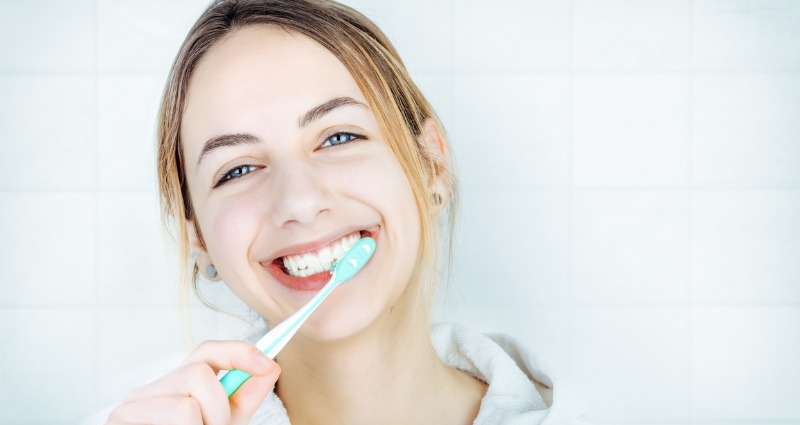
When you have braces, there’s no hiding your poor teeth brushing. Bacteria and plaque love unbrushed teeth, particularly all the nooks and crannies braces provide. Brushing after every meal not only removes food particles from between your teeth and braces but helps keep your teeth and gums healthy, which is important for all orthodontic patients. Regardless if you have braces or not, you should avoid making these mistakes and start brushing your teeth the right way.
#1 Not Brushing Multiple Times a Day
If you’re only brushing your teeth at night or in the morning, you aren’t brushing enough. Ideally, you should brush your teeth three times per day when you’re wearing braces, after breakfast, lunch and tea. But if brushing after lunch isn’t always possible at least rinse thoroughly with water and brush your teeth well morning and night.
Brushing is the only way to remove food particles and harmful bacteria from your mouth after every meal. Without brushing often, you are risking tooth decay and teeth staining which won’t be clear until we remove your braces.
#2 Not Using the Right Technique for Braces
Brushing your teeth isn’t the same when you have braces. There’s a lot more inside your mouth besides teeth and gums that need your close attention. All the surfaces of the brackets need cleaning with a toothbrush.
To brush properly, hold your toothbrush at a 45-degree angle under the bracket to brush. Next hold the brush flat on the face of the bracket to brush and then at a 45 degree agree above the bracket to brush.
Don’t forget to brush along the gum lines, the chewing surface of your teeth and the side of the teeth without brackets (the back for traditional braces). Give every bracket and every tooth your attention to ensure they’re clean and healthy.
#3 Skipping Flossing
Your toothbrush can’t clean between teeth, so any food and bacteria that’s trapped between the teeth can harden into plaque. Flossing is the only effective way to clean between teeth and the gumline. By flossing daily you can remove bacteria and stop the plaque forming. But you need to do a thorough job.
There’s a saying ‘only floss between the teeth you want to keep’. People tend to floss between the teeth they can see in the mirror but don’t worry about the hard to reach molars at the back. It’s important you floss all teeth including the back ones.
#4 Not Brushing for Long Enough
There’s no such thing as a quick brush of your teeth when you have braces. Without braces we should all spend at least two minutes brushing, but a thorough brush of every bracket and tooth will take you a little longer with braces.
If you’re using a manual brush and you’re not sure if you’re brushing for long enough, use a timer on your phone set for at least two minutes and if you haven’t finished at the end of the timer, continue brushing. Swapping to an electric toothbrush is a good idea because of its built-in timer, so you aren’t tempted to skimp on your brushing.
#5 Using The Wrong Toothpaste
The Orthodontists recommend using a fluoride toothpaste or gel to brush your teeth. Never use a whitening toothpaste when you’re wearing braces, save it for after your braces are off.
When you have retainers, don’t use any kind of toothpaste to clean them. Toothpaste is too abrasive and can damage the thin plastic.
#6 Not Realising Your Toothbrush Needs Replacing
Braces are hard on toothbrushes. Before braces, your toothbrush may have lasted you months with little sign of the bristles fraying. Brushing with braces can place wear and tear on your toothbrush within weeks. And a worn toothbrush with its bristles out of shape isn’t as effective as one that is undamaged. It’s best to replace your toothbrush once it’s showing signs of wear, so you can be confident that it’s removing food, bacteria and plaque from your mouth every time you brush.
Old toothbrushes can also harbour bacteria that isn’t removed when you rinse your brush. By replacing your toothbrush regularly you can be confident it doesn’t have the same level of food particles and bacteria as an old brush.
Considering Orthodontic Treatment for Your Child?
There are many advantages to starting orthodontic treatment for children at a young age. Improve your child's smile and book an appointment!
#7 Skipping a Professional Clean
No matter how good your tooth brushing is with or without braces, it’s still important to see your general dentist every six months for a professional clean. A clean and polish can help keep teeth stay stain-free, so there’s no white spots on your teeth when it comes time to remove your appliances.
Ask for Help
Brushing your teeth with braces takes time to get used to. With some practise, it will become second nature, but in the meantime if you have any questions, call the clinic. It’s best to get an answer before your next appointment. If you would like another demonstration on brushing, ask your therapist.